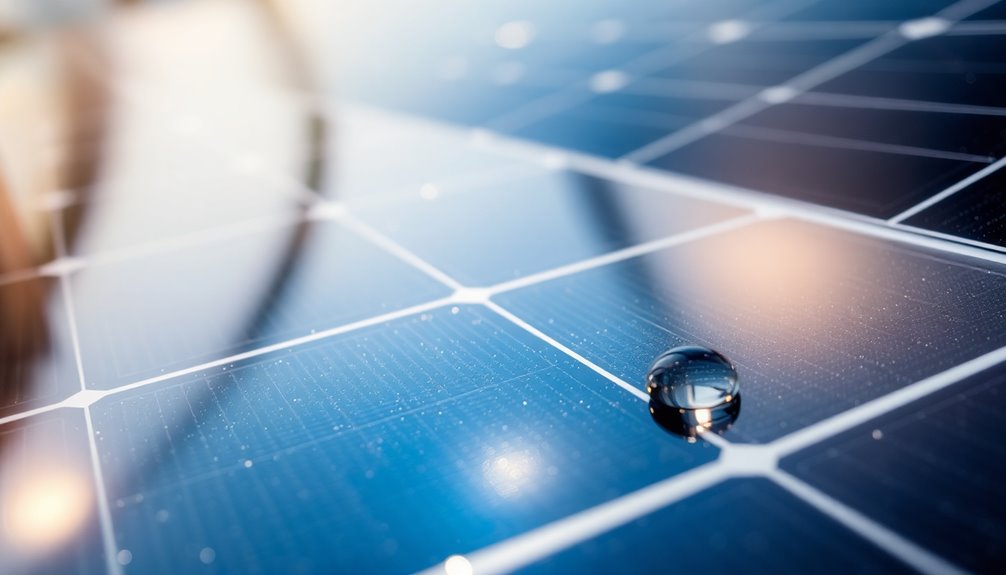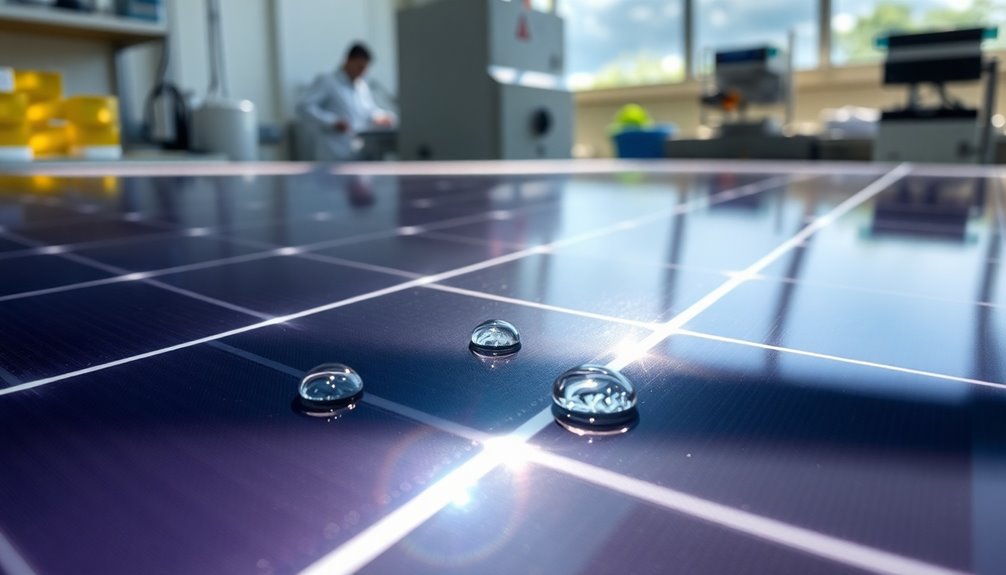Per- and polyfluoroalkyl substances (PFAS) in solar PV modules can raise concerns about environmental and health risks. While PFAS aren't usually in main panel components, they might appear in coatings or adhesives. Most manufacturers now opt for safer alternatives. However, older models could contain PFAS, and degradation under UV exposure can result in harmful chemical release. Understanding these implications is crucial as solar technology evolves, and there's more to uncover about their impact on sustainability.
Key Takeaways
- PFAS are chemicals used in some coatings and adhesives in solar panels, providing water and stain resistance.
- Research indicates no PFAS leaching occurs during normal solar panel use, minimizing immediate health risks.
- Older or non-standard solar panels may contain PFAS; evaluating each model is essential for safety assessments.
- Degradation of PFAS coatings can release harmful chemicals when exposed to UV light, posing environmental risks.
- Regulatory frameworks are evolving to monitor PFAS in solar technology, emphasizing the need for compliance and sustainability.

As concerns about environmental safety grow, understanding per- and polyfluoroalkyl substances (PFAS) in solar PV modules becomes crucial. PFAS are a group of chemicals known for their water, oil, and stain-resistant properties, found in many consumer products like non-stick cookware and stain-resistant fabrics. While they offer practical benefits, their persistence in the environment and potential health risks have sparked significant concern.
Exposure to certain PFAS compounds has been linked to serious health issues, including low infant birth weights and various cancers, making it vital to examine their presence in solar energy technologies.
Exposure to PFAS compounds is linked to serious health issues, highlighting the importance of assessing their presence in solar energy technologies.
In solar panels, PFAS aren't typically part of the main components but may appear in specific coatings or adhesives. Research indicates that there's no evidence of PFAS leaching from solar panels during regular use, and many manufacturers favor non-PFAS alternatives. However, you should be aware that older or non-standard solar panels might contain these substances, so assessing the specific models you're considering is essential. Additionally, concerns exist about potential damage from severe weather conditions that may increase the risk of leaching from compromised panels.
The health risks associated with PFAS exposure are concerning. These chemicals are highly mobile in the environment, capable of bioaccumulating in organisms. They persist in soil and water, posing long-term environmental hazards. Contaminated drinking water and food sources can lead to exposure, raising alarms about the broader implications for public health and ecosystems.
Some solar panel coatings may use PFAS for added durability, although they're not widespread. While these coatings generally remain stable under normal conditions, degradation can occur when exposed to UV light, potentially releasing harmful chemicals. Improper disposal of these materials further exacerbates environmental risks, making it crucial to consider disposal methods when evaluating solar technology.
Regulatory frameworks are evolving to monitor PFAS usage in solar panels, with agencies like the U.S. EPA actively addressing health risks. As awareness increases, compliance with these regulations becomes essential to ensure the safety and sustainability of solar energy solutions.
Frequently Asked Questions
What Are the Health Effects of Exposure to PFAS?
Exposure to PFAS can seriously impact your health.
You might experience weakened immune response, making you more susceptible to infections and impacting vaccine effectiveness.
Long-term exposure raises your cancer risk, particularly for kidney and testicular cancers.
It can also affect reproductive health, leading to lower birth weights and potential developmental delays in children.
Given their environmental persistence, you could encounter PFAS through contaminated water, food, and various consumer products.
How Can PFAS Contamination Be Tested in Solar PV Modules?
When it comes to testing for PFAS contamination in solar PV modules, you'll want to leave no stone unturned.
You can use techniques like liquid chromatography-tandem mass spectrometry (LC-MS/MS) for high sensitivity. Non-destructive methods like PIGE spectroscopy help screen for total fluorine content.
Make sure to follow quality control measures during sampling and compare your results against established safety standards to ensure reliable data and compliance with regulations.
Are There Regulations Governing PFAS in Solar Products?
Yes, there are regulations governing PFAS in solar products.
You'll find the EPA enforcing reporting requirements under the Toxic Substances Control Act, while some states have enacted bans on PFAS in consumer products, including solar panels.
Internationally, frameworks like the EU's REACH regulations restrict PFAS use.
As awareness grows, companies must adapt to these evolving regulations, ensuring compliance and seeking safer alternatives to maintain their market position and environmental responsibilities.
What Alternatives Exist to PFAS in Solar Panel Manufacturing?
When considering alternatives to PFAS in solar panel manufacturing, you'll find non-toxic coatings, silicone polymers, and non-fluorinated adhesives.
You can explore nanoparticle coatings, silicon-based chemistry, and recyclable materials for improved sustainability.
You should also look into innovative approaches like self-cleaning coatings and smart polymers.
As market demand grows for sustainable products, these alternatives not only mitigate environmental impact but also enhance the durability and efficiency of solar technologies.
How Do PFAS Affect the Recycling of Solar PV Modules?
PFAS complicate the recycling of solar PV modules significantly.
When you try to recycle these panels, the presence of PFAS makes mechanical and thermal processes less effective, as they can lead to harmful emissions.
Additionally, their persistence means that PFAS can leach into soil and water during disposal.
To tackle these issues, focusing on safer materials and innovative recycling methods is essential for achieving effective and sustainable solar panel recycling.
Conclusion
In conclusion, it's essential to grasp the role of per- and polyfluoroalkyl substances in solar PV modules. As the saying goes, "An ounce of prevention is worth a pound of cure." By understanding these substances, you can make informed decisions and advocate for safer alternatives in solar technology. Together, we can ensure a cleaner, greener future while harnessing the power of the sun. The more we know, the better we can protect our planet.









